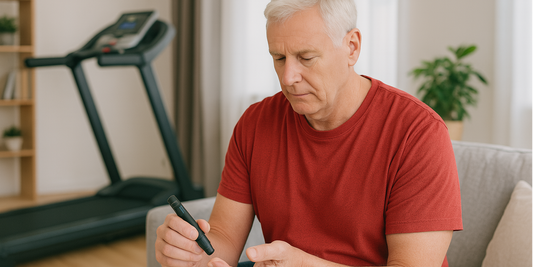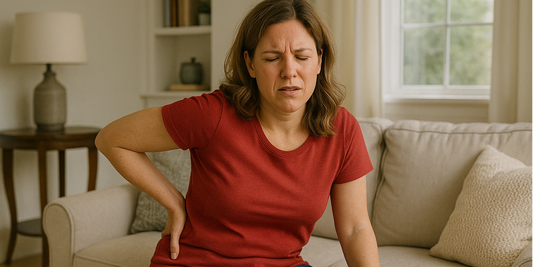
No Pain, No Gain: Fixing At-Home Workout Mistakes Before They Happen
Share
The rate of at-home exercise-related injuries resulting in a very unwelcome trip to the ER jumped over 48% from the end of 2019 to the end of 2020. A lot of this can be attributed to the global pandemic, but it does show a trend that when we don’t proactively take care of our bodies, we risk injuries that can slow down the rest of our day.
As part of our commitment at Redliro to keep you feeling great through at-home workouts, we wanted to add a follow-up article on our recent “Get Fit at Home Simple Home Exercises for a Fantastic Beginner Workout.” The goal here is to give you some great tips to avoid back pain or have your knees hurt during a fitness routine. Let’s jump right in!
Top At-Home Workout Mistakes to Avoid
To attain fitness without injury, you’ll want to consider the specific “at risk” areas of your body related to the exercises you’re completing.
Every type of movement has a risk that most of us ignore because they don’t hurt – until they do! Try to avoid experiencing this pain by dodging these common pitfalls:

Lower Back Pain from Squats
When you’re working through a squat, you want to have perfect form. Be sure to align your feet with your hips and shoulders while you go through the movement. Anytime you experience an “off-kilter” squat where you are leaning too far to the side, back or forwards, you risk your lower back pain.
An excellent way to help with this challenge is to maintain a neutral spine and never go as far down below your pressure level. Hold off on adding hand weights until you are 100% confident in your form and durability during repetitions.

Knee Pain from Lunges
Your knee is one of the most essential joints you have in your body. It is a critical identifier of how well you’ll do in later life because it represents your ability to stand up from a sitting position. Knee injuries are incredibly common, especially if you’re trying to do too many reps or carrying extra weight.
Some easy tips to avoid this injury involve bending only halfway through your lunge. You want to develop this muscle, not tax it. Try to go backward instead of forwards. Reverse lunges focus more on form and not momentum.

Shoulder Pain from Planks
We’re back to talking about form again. Always bend your elbows at a firm 90 degrees and hug your ribs with your forearms parallel to the floor. This will help you avoid a rolled-over shoulder that can quickly become painful.
The trick here is only to go as far as you can while maintaining your stiff form (hence the name as stiff as a wooden plank). Whenever your hips get too low or high, your shoulders must compensate, which puts too much stress on them.

Wrists Injuries from Push-Ups
Your wrists aren’t just for typing or swiping. In push-ups, place them under the shoulders, not ahead, not beyond. A slight misplacement and the delicate wrist bears the grunt unfairly. It is all about maintaining that neutral position to avoid wrist extensions.
Keep your hands flat on the ground and keep your wrists straight. Whenever they bend in an “unnatural” way beyond that straight form, you are risking them being overtaxed, sprained, or injured.

Elbow Injuries from Pull-Ups
Elbows inward, grip firmly, and pull with strength from your arms and back. Elbows flaring out is a distress signal. Heed it. In fact, the most common injury relates to inner elbow pain during a pull-up, which you can avoid by widening your grip a little.
In these instances, you should keep ice packs on hand and some heat elements for a bit of therapy after your at-home workout. Whether your knees hurt from some split squats or you have extreme back pain, you should give yourself time to heal up before pushing the workout barrier more.

Simple Tips to Prevent At-Home Workout Pain
Pain prevention isn’t just about correction. This has way more to do with proactive care. That is all about building a solid at-home workout foundation. After all, the goal is to maintain your mobility, build some crucial muscle structure, and feel good from the benefits of exercise.
To keep you feeling fantastic during your at-home workout journey, here are some quick tips that should lower the chances of getting an injury or dealing with long-term pain.
Take Time for a Proper Warm-Up: Blood to muscles, like an invitation to a dance. Warm them up, let them know it’s time to move. The #1 cause of at-home workout injuries is not warming up. You should be spending about a quarter of your workout time doing some light cardio and stretching to warm your body up.
Stay Hydrated and Get Plenty of Sleep: Water is the elixir, and sleep is the restorer. Embrace them both, and in reasonable amounts. You should shoot for around 15.5 cups of water for a male and 11.5 cups for a female. As for sleep, you want about 7 to 9 hours a night. Think of this just like a car. You want your engine well lubricated and rested to operate efficiently.
Listen to Your Body: It whispers before it screams. A twinge here, a twinge there—heed its subtle cues. No one knows your body better than you. That little bit of discomfort you feel after doing 25 pull-ups (good for you, by the way!) is a red flag that something may be on the horizon. Be gentle with your body.
Give Yourself Time to Recover: Muscles tear to build. There are plenty of studies that show it takes anywhere from 24-72 hours of rest before the body is fully healed. That is why so many experts suggest varying your exercise routine so different parts can heal while you focus on others. Without that rest, you risk more significant injury from fatigue.
Conclusion
Your home is your personal fortress for at-home exercise. Whether you’re getting in a quick 25 minutes in between Zoom meetings or have a great Yoga session planned after arriving home from work, we want to help you maintain your overall health and abilities so you can stay active all year round.
Consider these tips carefully, and you should experience no issues in staying happy, healthy, and fit for your next at-home workout session. While you’re at it, be sure to check out our line of low-impact treadmills that are perfect for warming up, working out, or cooling down while you binge your favored streaming service. At Redliro, we have your at-home fitness covered!



